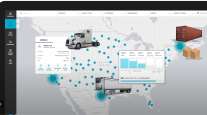Fuel Economy in Focus

For many fleets, onboard telematics has become an indispensable tool in the never-ending quest to improve fuel economy.
Truck telematics systems can help carriers uncover driver behaviors that contribute to fuel waste, including aggressive driving, idling and speeding. With that information at their disposal, fleets can better coach their drivers and identify opportunities to boost efficiency.
TECHNOLOGY=EFFICIENCY: ELDs present fuel-savings opportunities for fleets
“You can’t improve something unless you measure it. Telematics provides the data to the fleet in real time and lets them take action,” said Mike Roeth, executive director of the North American Council for Freight Efficiency.
Fuel management is one of the single biggest ways to manage expenses and find savings, said Dustin Quesenberry, vice president of operations for CFI.
The Joplin, Mo.-based truckload carrier has taken a multipronged approach to improving fuel economy, engaging multiple software providers to monitor drivers’ miles-per-gallon performance.
“We find that our drivers want to be good stewards on fuel consumption, but more often than not it is about awareness,” Quesenberry said, adding that CFI uses a driver scorecard that tracks mpg.
CFI monitors idle time through its onboard communication system and asks drivers to shut the engine off if temperatures are between 35 and 65 degrees, he said. “That boosts their mpg when they’re able to do that,” he said.
CFI also asks drivers to follow its fuel-routing application, which identifies the best places to purchase fuel and specifies how much fuel the driver should purchase.
“We realize that in some cases they can’t fuel in that exact place at that exact time, and we give them some autonomy and freedom with that,” Quesenberry said, adding that CFI focuses on buying fuel where it has the best negotiated pricing.
CFI is a TFI International company. Montreal-based TFI ranks No. 10 on the Transport Topics Top 100 list of the largest for-hire carriers in North America.
Some trucking technology vendors have made fuel management their primary focus.

Fleet managers can use the Vnomics web portal to assess the fuel efficiency of a driver, groups of drivers or an entire fleet. (Vnomics)
One such company, LinkeDrive Inc., offers real-time, in-cab driver coaching through its PedalCoach application.
Driver performance accounts for one-third of a truck’s fuel economy, said LinkeDrive CEO Jeff Baer.
“The driver controls many inputs to efficiency,” such as the accelerator pedal, brake pedal and steering wheel, all of which can be coached, he said.
With PedalCoach, fleets also can introduce “gamification,” which increases driver engagement.
“With the game, the reward is more than the monetary penny or two per mile that people get for fuel economy. It’s about the recognition, development and positive feedback that they get from the game,” Baer explained.
Another vendor, Vnomics, combines real-time driver coaching, vehicle monitoring and fuel use analytics through True Fuel, a stand-alone system that fleets can implement regardless of the onboard technology platforms they have deployed.
True Fuel identifies the maximum achievable mpg for a particular vehicle with its given load, then compares the driver’s actual performance with that benchmark given the truck, load, route and other external conditions, said Andy Markese, vice president of sales and marketing for Vnomics.
True Fuel assesses driver behavior by looking at factors such as shifting performance, engine-speed control, idling and speeding, and provides real-time coaching using audible tones designed to guide the driver toward the most efficient operation, Markese said.
Superior Plus Energy Services, a fuel supplier based in Rochester, N.Y., has invested in about 300 True Fuel systems to coach drivers if they’re braking harshly or not shifting at the optimal points.
“The unit has all the time in the world to coach the driver. I don’t,” said Bruce Ruppert, director of business development for the company. “It is real money for us in fuel savings.”
True Fuel also groups equipment information and can identify when similar spec’d trucks are not as efficient as others.
“Within that context, we can identify potential maintenance issues that could be degrading mpg,” Vnomics’ Markese said.
Some fleets use True Fuel to link driver fuel efficiency with compensation, allowing them to reward drivers for their performance.
“It calculates exact driver efficiency and continuously recalibrates for load, route and weather,” Markese said.
Many other telematics firms also offer fuel-economy applications.
Mark Wallin, vice president of product management for Telogis, said that drivers consume less fuel when they are more conscious of how they are driving, saving the company money and making the drivers more valuable.
Telogis Coach provides in-cab alerts, and fleet managers can monitor the elements that are the most important to the fleet. Drivers have direct access to their driving score, which is updated daily. Wallin said the technology gives managers insight into drivers who might need additional training or coaching.
The visibility provided by telematics helps dispatchers ensure the truck is taking the most efficient route. It also can help ensure jobs are assigned in the most efficient manner, possibly allowing fewer trucks to be dispatched and reducing travel time between jobs, Wallin said.
Pete Allen, chief client officer at MiX Telematics, said fuel economy starts in the cab, which is why driver coaching is a key element of improving efficiency.
“If you think about what impacts fuel economy the most, it is the driver,” he said.
Allen said he, too, has seen many fleets create incentives or gamification programs to make improving fuel economy a competition.
“Make it fun for the driver. Have apps or post reports so everyone is aware of the impacts they’re having on the fuel economy,” he said.
Instantaneous, in-cab feedback can help drivers correct bad habits and immediately improve fuel economy, said Eric Witty, vice president of product management for PeopleNet.
“If you think there are problem areas, there are ways to drill down to see why the performance was the way it was,” he said.
Solar Transport, a bulk carrier based in West Des Moines, Iowa, has deployed technology from PeopleNet and SpeedGauge.
The company’s investment in telematics has yielded more than $250,000 in fuel savings, said Jason Jones, the carrier’s information technology manager.
“PeopleNet reporting gives us long idle, short idle, mpg and over-rpm, whereas the Speed Gauge application gives us data on drivers that are speeding and the GPS locations and speed zones of that driver,” Jones said. “These alerts are then able to notify drivers and allow us to coach and help drivers to understand the importance of the data.”
Telematics can uncover a variety of bad driving habits.
For example, a driver who is routinely following close behind a vehicle may engage in harsh braking, said Wes Mays, director of OEM solutions for Omnitracs.
“Pointing that out to the fleet helps them improve driver behavior. It is a learning and education process for the driver and the fleets,” he said.
C.R. England Inc., a refrigerated carrier based in Salt Lake City, uses Omnitracs to monitor driver performance.
The fleet focuses on drivers’ time in top gear and cruise control as well as idle performance — the three factors with the greatest impact on managing fuel economy, said Ron Hall, vice president of equipment and fuel for the carrier.
C.R. England publishes a weekly driver scorecard, comparing a driver’s fuel economy to that of his or her peers.
“That scorecard puts them in percentiles and they earn rewards they can redeem on a rewards website,” Hall said.
The carrier monitors idling in several ways, breaking it out by fleet and division, examining trends over time and identifying the bottom 10% drivers. The system also generates maintenance work orders to ensure idle parameters are correct and have trucks examined to see if maintenance is needed.
C.R. England ranks No. 26 on the TT Top 100 list of for-hire carriers.
Christian Allred, manager of global sales for technology provider Orbcomm, said unnecessary idling is one of the first and easiest behaviors to address with drivers.
Sending route information to onboard navigation software allows fleets to utilize the lowest-cost route, which may factor in distance, time, tolls, elevation gain and average speed, Allred added.
Several telematics systems, including FleetLocate from Spireon Inc., monitor vehicle health diagnostics, another key factor for fuel consumption.
For example, knowing the status of a vehicle’s tire pressure and alerting managers when the tires are low can improve fuel economy, said Reza Hemmati, director of product management at Spireon.
FleetLocate also gives fleets visibility into asset location and traffic data, which helps with dispatching and reducing a vehicle’s total time and number of miles on the road, Hemmati said.
Software provider Carrier Logistics Inc. helps less-than-truckload carriers select optimum routes and reduce mileage, which the company said can lead to savings of 10% to 15%, depending on the fleet.
“It involves trying to plan for the shipments expected to be available and delivering them in a way that balances customer expectations against efficiencies, which is miles,” said Ben Wiesen, CLI’s vice president of products and services.





